AWS Amplify
Overview
AWS provides numerous cloud services that have accelerated developer's tasks by offering fast, simplified, efficient, serverless, and secure web and mobile application development. One such AWS service is AWS Amplify which has accelerated the developer's job to build full-stack web and mobile applications in hours seamlessly.
The AWS Amplify is easy to start, easy scale complete solution that removes the stress from developer's shoulders as it is a complete solution that lets the frontend web and mobile developers easily and quickly build, ship, and host full-stack applications on AWS, along with the flexibility to leverage the breadth of AWS services as scenarios evolve.
What is AWS Amplify?
While creating a full-stack web application, you might have spent days coding the frontend UI, and then seamlessly integrating this UI with the backend services is another struggle for developers. But with fast-growing digital transformation, business needs to scale their website creation from days to minutes and seamlessly start leveraging the digital transformation to reach their target customers.
With that being said, AWS offers AWS Amplify which is the complete solution where you get a fully managed full-stack web and mobile application where you can build, ship, as well as deploy services in hours. AWS Amplify is easy to start and scales quickly. Launched in 2017, AWS Amplify is a full package of all the required services and tools designed to help developers easily build, quickly deploy and host their applications.
The key points to consider when we talk about AWS amplify are:
- Create your AWS backend with ease and in minutes along with secure authentication, data, storage, and more.
- Seamlessly build your frontend UI with the Figma integration offering design-to-code in a few clicks.
- Easily deploy and Quickly host your secure, rapid, reliable websites along with server-side rendered applications.
- Scale your application capability with 175+ AWS services integration offered to AWS Amplify which seamlessly supports DevOps practices, new scenarios, and business growth.
You can quickly and securely integrate with a multitude of functions ranging from APIs to AI. This can include ready-to-use components, code libraries, and built-in CLIs.
Another feature that makes AWS Amplify so popular is the User experience as it conveniently integrates the UI/UX across various platforms offering the developers/customers a seamless experience. The flexibility to select the building elements for front-end development makes full-stack development much more comfortable than ever before. All this happening within a matter of a few clicks and hours helps businesses go online super fast and be a part of the digital transformation.
How Does It Work?
Now let us discuss the working of AWS Amplify to build full-stack web applications quickly in hours.
We need to know that the AWS Amplify has the backend framework as the JavaScript library for building, developing as well as deploying full-stack serverless applications on the cloud with a combination of both client-side and server-side code.
The key components which collaboratively work together to easily manage your application development lifecycle by using AWS Amplify are discussed below:
CLI Toolchain: If you want your application to be scalable enough, you can implement them with the CLI toolchain which increases the capability of your application to add more cloud features as well as services, and CLI commands which are quite easy to use and can efficiently make upgradation to your AWS-managed backend.
Libraries: For connection, integration, and convenient interaction with other AWS cloud services, you can use the library feature to easily add serverless APIs, analytics, secure authentication, data storage, file storage, push notifications, and many more features.
UI: With the pre-built UI components offered by AWS Amplify, you can easily and quickly build your application front. These UI elements are designed around the cloud workflows for your application like secure authentication for the higher-order component.
Below are a few diagrams that show how we can work with AWS Amplify work:
Create an APP Backend: For your iOS, Android, Flutter, web, or React Native app, You can swiftly create a cross-platform backend with real-time and offline functionality in a matter of few clicks.
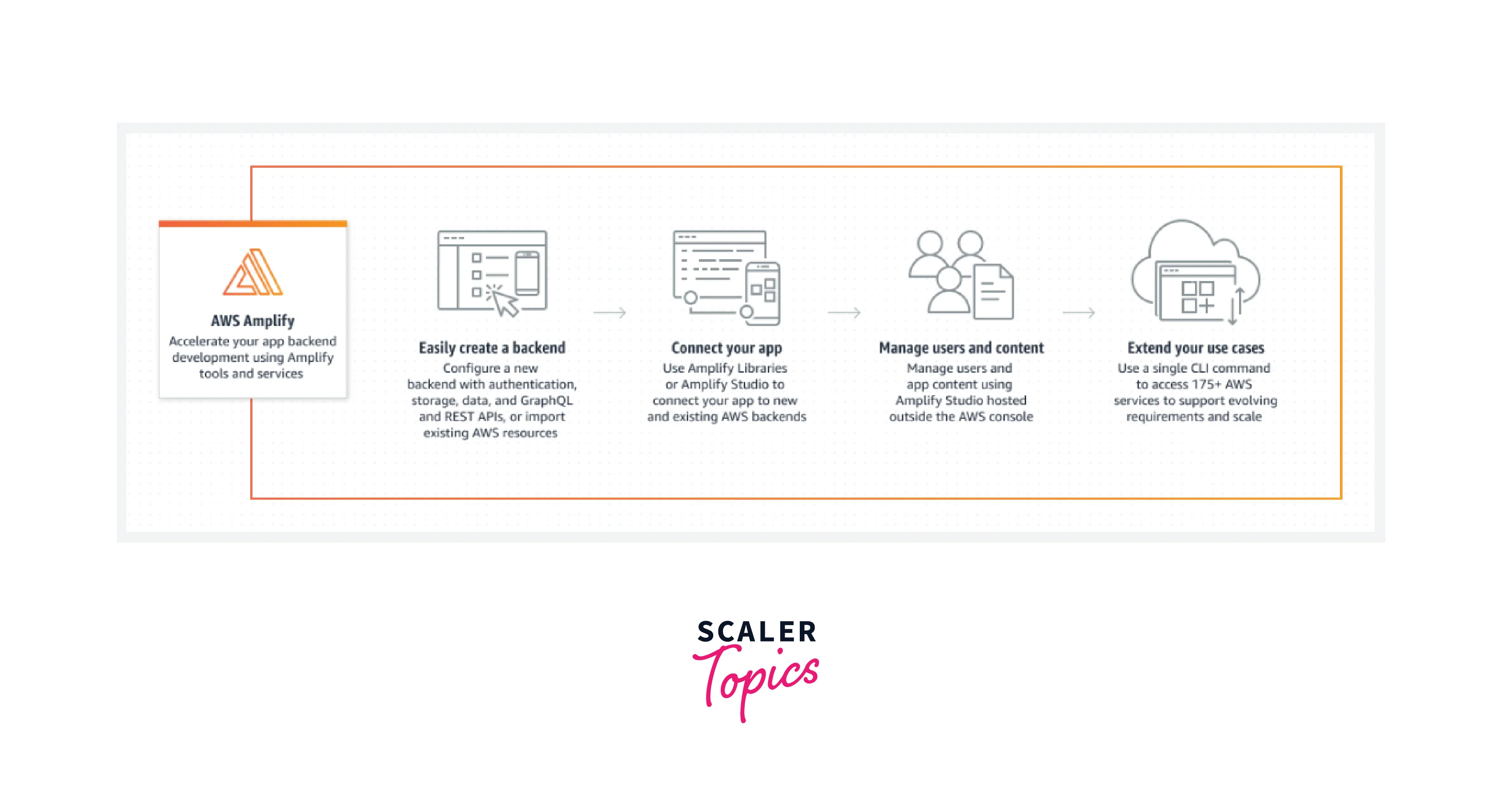
Build a UI: With a few lines of code, AWS Amplify can help create a visually pixel-perfect UI that could also be connected to a cloud backend in a matter of a few clicks.
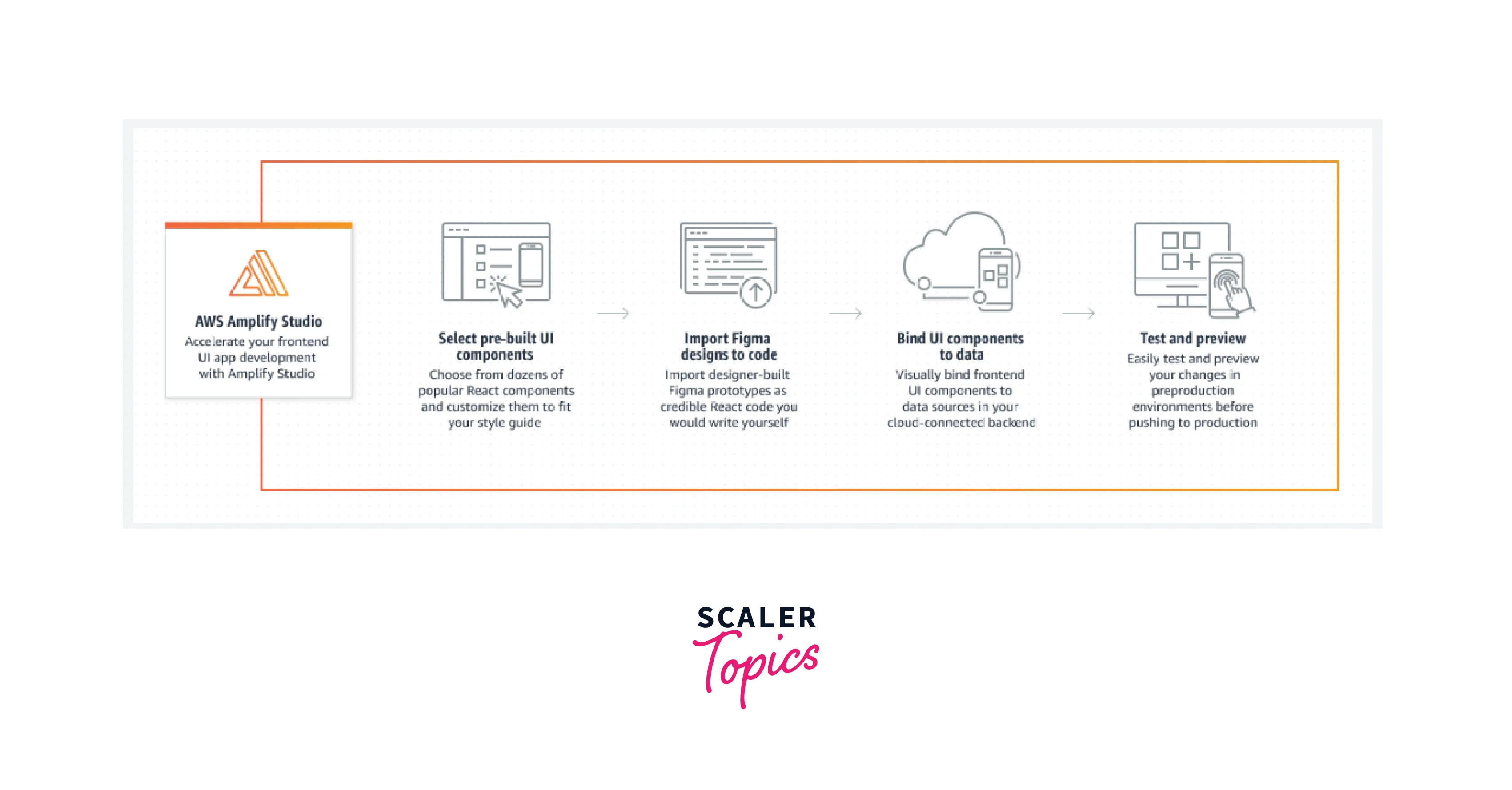
Hosting web Application: With AWS amplify you can quickly deploy your web application with a secure, and reliable content delivery network (CDN) to hundreds of points of presence globally.
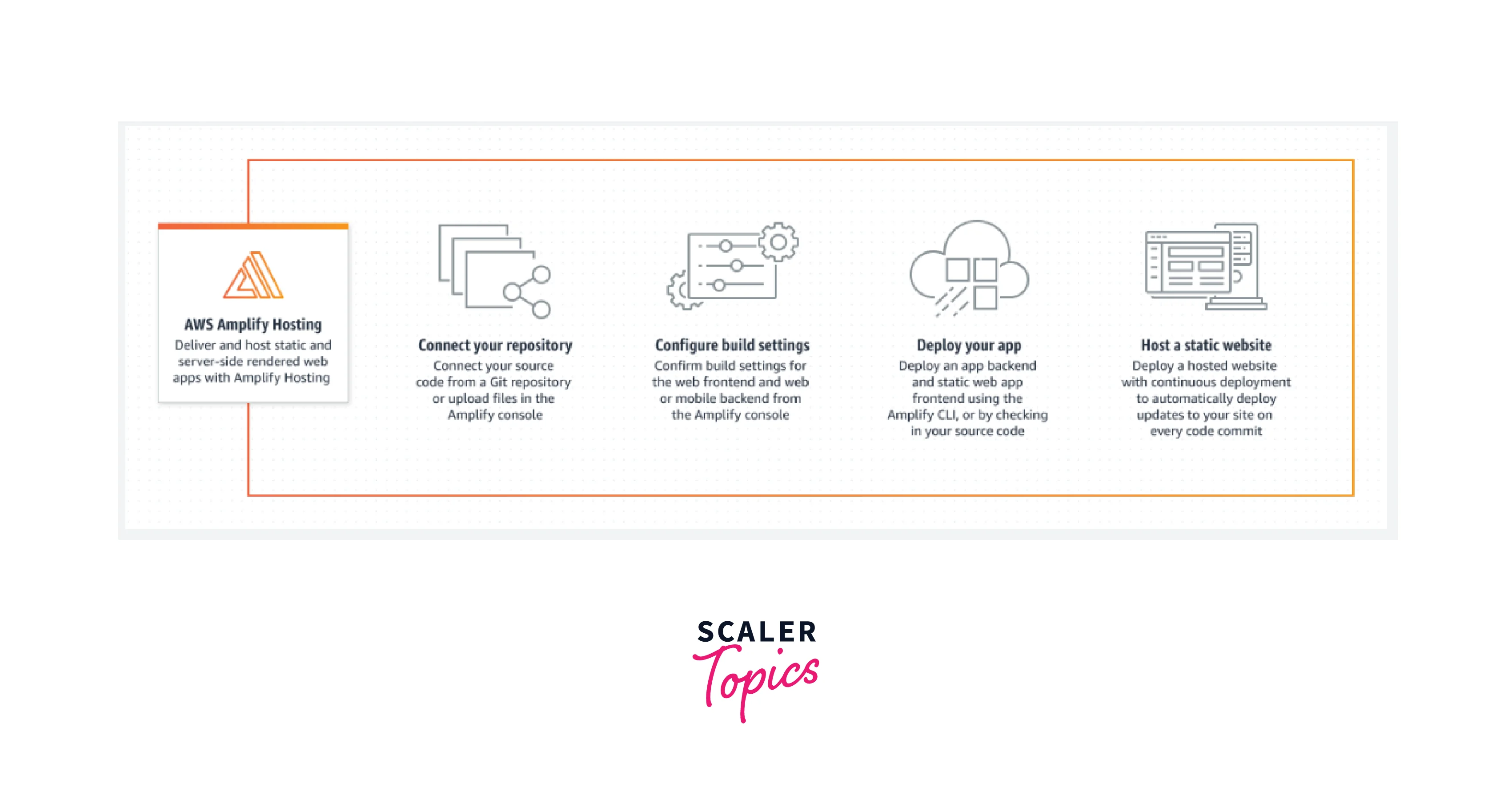
AWS Amplify Features
The various features offered by AWS Amplify are categorized into four major parts listed below:
- Build
- Ship
- Scale and manage
- Tools
Listed below are a few AWS services that support the AWS Amplify while we build and deliver the full-stack web application:
| AWS Amplify feature | AWS Service |
|---|---|
| Authentication | Amazon Cognito |
| Push Notifications | Amazon Pinpoint |
| DataStore | Used by AWS AppSync client |
| Predictions | Amazon Rekognition, Amazon Textract, Amazon Comprehend, Amazon Translate, Amazon Transcribe |
| REST API | Amazon API Gateway |
| Storage | Amazon S3, Amazon DynamoDB |
| Interactions | AWS Lex |
| GraphQL API | AWS AppSync |
| Functions | AWS Lambda |
| PubSub | AWS IoT |
Now let us discuss each of the four sections and the descriptive features offered by AWS Amplify:
- For building your web application, you can leverage the Amplify Studio or Amplify CLI which can configure the application's backend easily. Then for integration, you can use the Amplify libraries and UI components.
- When you start building your full stack web application, the seamless Authentication ( Powered by Amazon Cognito.) can be created with onboarding flows containing a fully-managed user directory containing pre-built sign-in, multi-factor auth workflows, sign-up, and forgot password. The login is also supported by social providers like Google Sign-In, Facebook, or Login With Amazon.
- The DataStore (Powered by AWS AppSync.) offers a programming model for cross-user and distributed data without the hassle of writing additional code lines. This is a multi-platform (iOS/Android/React Native/Web) on-device persistent storage engine that is capable of synchronizing data between mobile/web apps and the cloud automatically.
- Lastly, for building a web application, you also require data Storage (Powered by Amazon S3.), and for that The AWS Amplify Storage module works best. You can store, manage and leverage cloud-scale storage for all the user-generated content like photos, and videos securely between the device and the cloud.
Below image shows different tools offered by AWS Amplify for building your web application:
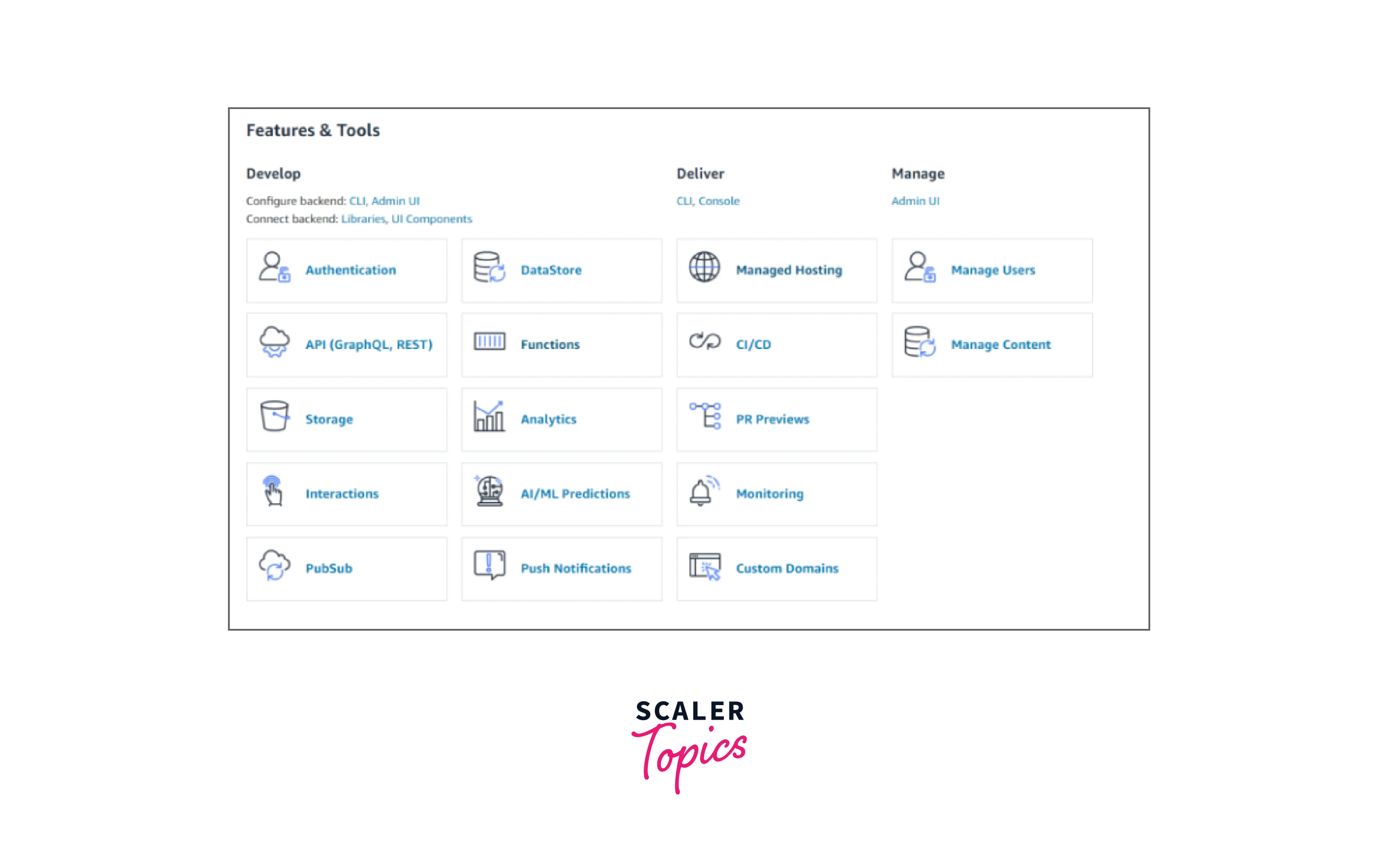
- For shipping your web application, you can use the Amplify console or CLI to host your static mobile applications. The AWS Amplify Hosting offers a fully managed service with built-in 'CI/CD' workflows for quickly deploying and seamlessly hosting your full-stack web applications. You can easily connect your application's code repository stored in the Amplify console, and make changes to either the frontend or backend when they are deployed on every code commit.
Below shows the different AWS services supporting the shipping of your web application process:
| AWS Amplify feature | AWS Service |
|---|---|
| Monitor | Amazon CloudWatch |
| Host | Amazon CloudFront, Amazon S3 |
| CI/CD | AWS Amplify console |
-
For conveniently scaling and easily managing your web application, you can implement the Amplify Studio.
- Content management can be done by providing access to the content editors and testers by the developers to update the application data via Amplify Studio where the admins also get the option to save content as markdown to render the rich text.
- Whereas User management is also quite easily managed by the Amplify Studio where you can create and edit users and groups, auto-verify signups, update the properties, and more, without any long verification process.
-
For Tools offered by AWS Amplify, let us discuss each one by one as these are the key building block that you may extensively use to build and deploy your application.
- AWS Amplify Studio: With AWS Amplify Studio, a developer can easily and quickly develop backends along with seamlessly managing the application content. It generates automatic templates enabling seamless integration with the Amplify CLI, helping you extend your application backend with additional capabilities.
- AWS Amplify Hosting: To configure the backend and manage app content and users, use the AWS Amplify Hosting tool that can allow you to quickly host front-end web applications, set up CI/CD, create or delete backend environments, etc.
- AWS Amplify UI components: The open-source UI toolkit which includes the common cloud-connected workflows provides drop-in UI components that give secure authentication, storage, and interactions, in addition to the style guide that allows you to choose from various templates.
- AWS Amplify CLI toolchain: To quickly configure and maintain your application backend, you can just the AWS Amplify Command Line Interface (CLI). With its interactive workflow and intuitive scenarios, you can test features, deploy multiple environments, and offer pre-configured resources to customers (infrastructure-as-code templates) helping easy integration and team collaboration with Amplify's CI/CD workflow.
- AWS Amplify Libraries: AWS Amplify offers various libraries like JavaScript, Android, iOS, or Flutter. With its scenarios-based open source libraries, you can seamlessly build mobile and web applications powered by AWS services and can integrate them with new backends (built by the Amplify CLI and Amplify Studio, or even your existing AWS backend).
AWS Amplify Modern Tools and Services
As we studied so far, by implementing AWS Amplify we can easily build full-stack web applications in a matter of hours. With that being said, below are the few modern tools and services that are offered by AWS Amplify:
Amplify Studio: The AWS Amplify Studio offers its customers Visual Interface. You can easily build and quickly deploy the full-stack web application with its point-and-click environment including frontend UI and backend. Amplify CLI: The AWS Amplify CLI, abbreviated as the Command Line Interface. Manage as well as adjusting the configuration of the application's backend with a few commands can now be done easily with the local toolchain. Amplify Libraries: The AWS Amplify Libraries are also known as the Open-Source Client Libraries. This service offered by AWS Amplify builds cloud-powered mobile and website applications with its vast open-source client libraries. Amplify UI Components: The AWS Amplify UI components offer the open-source Design System feature. With cloud-connected components, this open-source design system for building and creating feature-rich applications fast. Amplify Web Hosting: The AWS Amplify also offers a fully managed CI/CD and web hosting platform with its service called AWS Amplify Web Hosting. This service offers reliable static, fast, and highly-secure, and server-side rendered applications.
How Does Amplify Integrate with Other AWS Services?
With AWS Amplify you can simply build full-stack web and mobile apps in hours which are easy to scale and can be started quickly. When we talk about integrating AWS Amplify with other AWS services we can say that AWS Amplify offers the elements required to build the User Interface that is mainly used for CLI toolchain, cloud-oriented workflows, and code libraries.
While integrating you simply need to employ the code libraries ( either mutually, interchangeably, or independently) without the hassle to adjust the UI of the existing application. AWS Amplify brings you the best of both worlds that is, the amalgamation of your existing frontend application with AWS Amplify can be quickly done by simply adding a few code lines to your existing code structure.
When you have a scenario where you need to completely rebuild the backend then you can do so by implementing the AWS Amplify toolchain to rebuild the resources. Either you can connect the AWS Amplify with the existing data store, or you can provision a new data store with the AWS Amplify provision that has the migrated data.
Build an AWS Amplify Application
Now let us learn how we can set up the AWS Amplify in our AWS account by following the below-given steps:
Step 1: Start by login into the AWS account and selecting the AWS Amplify service in the services tab.
Step 2: Now, select “Get started” under the deliver once you are in the AWS Amplify console as shown below.
Step 3: This shall direct you to the same page where you can start to host React or other applications by simply connecting the source code present in the Git repository. Or you can just scroll down and select the “Continue” button in the "From full-stack samples" option as shown below.
Step 4: We move ahead to authentication for which you can choose the “Authentication starter” and select the Deploy app option as seen below.
Step 5: You shall be directed to the next page, where you just need to select the connect to GitHub account option as shown below.
Step 6: Once the request is authorized by you, we can set the application name, choose the desired service role, and select the save and deploy option. This process is shown below
Step 7: It might take some time for creating the application once done you can move ahead to select “Continue”.
Step 8: Now your application may get created, but AWS takes some amount of time to provision, build, deploy, and verify the same.
Step 9: Once done, you will be able to see that AWS has created one front-end (master) and one backend environment (dev*). When the backend isn't created you can get started on the backend environment where you can add the users through the deployed front-end or the backend option.
Step 10: Now we are close enough, as our application is up and running we shall connect the application to the NoSQL database by implementing the GraphQL API.
Step 11: Now start by cloning the repository in your preferred local path from the fork created in the GitHub account. You can change the directory to the same destination by the following command.
Step 12: Once the directory is successfully changed, we need to install it along with configuring the Amplify CLI. For installing the amplify CLI we can use the following command.
Step 13: We shall move ahead to create a user having the AdministratorAccess in your account so that it can provide the AWS resources for you such as AppSync, AWS Cognito, etc.
Step 14: Once the user creation is completed, you need to provide accessKeyId and the secretAccessKey which the Amplify CLI will ask you. This key will help to connect the Amplify CLI with the newly created AWS IAM user.
Step 15: After configuring the Amplify CLI, connect to the backend from your local machine where you need to create an Amplify project by the following command.
Step 16: You can add the GraphQL API using the following code.
Step 17: Lastly, you can deploy the changes in the cloud by running the following commands.
Step 18: Finally, you can visit the Amplify Console to see the added API categories where you can choose the API category helping you to navigate to the AppSync Console.
Voila! You finished creating the application with user sign-in by simply using AWS Amplify.
AWS Amplify Pricing
AWS Amplify comes with the following price structure:
For the Free Tier, you get a trial period of 12 months free as one of the first payment methods. Whereas for the Pay As you Go Model, you only pay forte the services you use. Once you have completed 1 year of usage with AWS Amplify: After the first 12 months, the free tier is converted to a pay-as-you-go model which means you only pay for the service that you utilize for developing and deploying your application.
The pricing breakdown for the services in the pay-as-you-go model is that you don't get charged for using the components and libraries of the framework but only for the services you utilize like S3 for storage of data, then you will be billed for S3 only.
Amplify Framework Pricing Structure: You only get charged for the AWS services you use without having to pay any extra or upfront cost for the Amplify Framework (Libraries, CLI, UI Components).
Static Web Hosting Pricing Structure: Here the pricing is divided into two parts: build & deploy, and hosting for using the AWS Amplify Console. With that being said, you get charged $0.01 for the build & deploy feature while you get charged per GB at $0.15 for the hosting feature where whereas to store this hosting feature you need to pay per GB $0.023.
If we talk about the AWS Free Usage Tier, AWS offers to =all its new customers no fee when you get started where you receive 1,000 build minutes per month for its build and deploy feature, whereas, for its hosting feature, you get charged 15 GB served per month and 5 GB data storage per month.
The below image represents the pricing structure offered by AWS Amplify for both FreeTier and Pay-as-you-go plans:
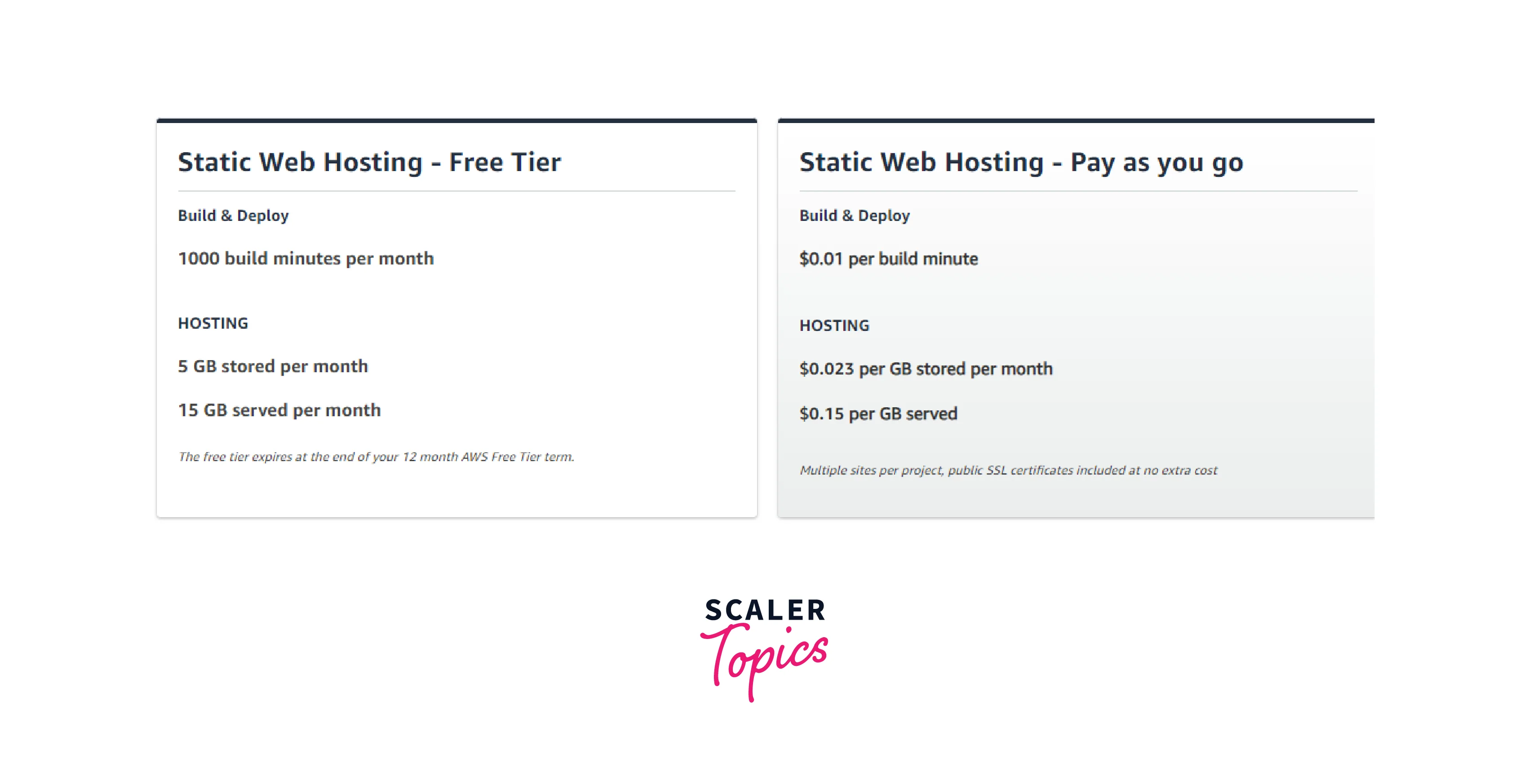
Advantages and Disadvantages of Using AWS Amplify
Now below have discussed a few advantages and disadvantages of using AWS Simplify to build your full stack application in a matter of hours:
Advantages of AWS Amplify:
- AWS Amplify offers an easy, quick, and modern UI-driven approach for building applications with its 'out-of-the-box' UI component which ease the work of the developer and reduce the lines of code as well.
- With the implementation of AWS Amplify, the application performance is also improved as it offers built-in support for all its backend management.
- Like many other paid AWS services, the pricing structure of AWS Amplify is not only cost-effective but also flexible enough to cost you only for the service you have utilized for building and deploying your application.
- With the web-based analytics dashboard, AWS Amplify comes as a really useful service for designers, developers, and project managers. This web-based analytics allows teams to easily manage and quickly track projects with its always up-to-date feature.
Disadavanatage of AWS Amplify:
- With AWS Amplify a user always needs to be up to date as it is a constantly changing platform, offering new features now and then.
- The traffic distribution is not that well managed, as you can not use load balancers to distribute traffic which can affect your application when it received high traffic spikes leading to latency issues.
- As you get already coded elements to easily build the UI, it can be wrong for a beginner developer as it restricts you from getting the coding exposure which in the future can make it difficult to navigate issues and resolve them.
AWS Amplify Alternatives
The AWS Amplify alternative that is being offered in the markets is Parse, Firebase, Backendless, or Back4app.
Below image shows the various applications that offer the best android application backend as follows:

Back4app: Back4app offers a backend-as-a-service solution that provides a wide range of in-built features that could be used to build your applications.
Backendless: The Backendless is simple yet super-fast backends as a service that is platformless and comes with interesting features like caching, advanced security features, logging, real-time database to reallocation, etc.
Firebase: The Firebase is widely supported by Google and is recognized as the foremost application development platform which offers features like real-time databases, APIs to cloud hosting, smart analytics, etc.
Parse: The Parse is the open-source back-end platform that can automate image cache performance along with providing features like push notifications to approx 1 million devices monthly at no cost.
Frameworks Supported by Amplify
The framework currently supported by AWS Amplify are:
[@graohic team to add images for the logos of these below-given frameworks.]
For website applications :
- Javascript
- Next.js
- React
- Vue
- Angular
For mobile applications:
- iOS
- Android
- Flutter
- React Native
- Ionic
Companies using AWS Amplify
Well, you might need that validation to trust the AWS service- AWS Amplify. Well, let us discuss how companies have leveraged its benefits to buy and deploy frontend as well as full-stack applications ranging from DevOps enterprises to startups which helped them rocket up their business.
Orangtheory: By delivering video workouts at scale during the pandemic, helped Orangtheory gain traction and hence skyrocket its business. Amazon Music: Built extensible application for millions of its users. » Credit Genie: With AWS Amplify, Credit Genie was able to make a seamless transition from file to production-grade in a moment of minutes Neiman Marcus: AWS Amplify helped Neiman Marcus to improve and increase its speed to the market by approximately 50%. Know: Leveraged AWS Amplify and integrated it with other AWS services to easily streamline its development process.
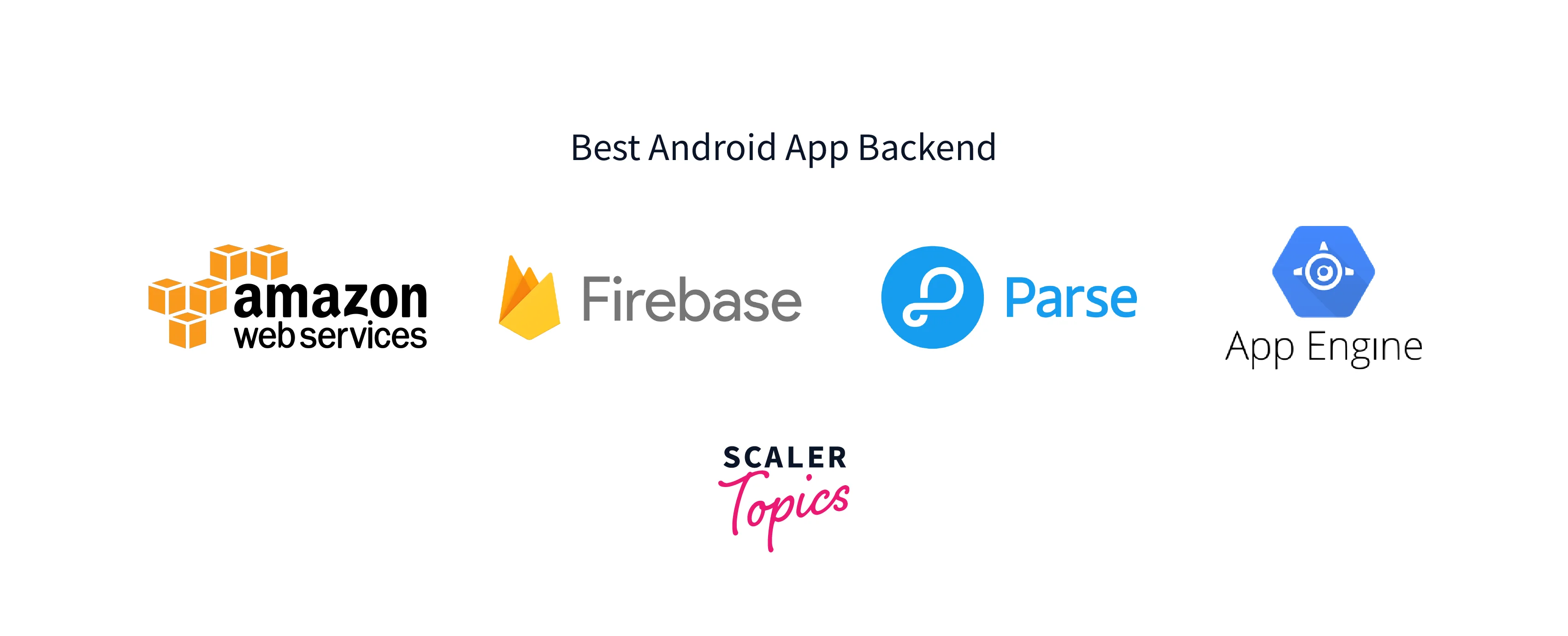
Conclusion
Some key takeaway points from the article are as below:
- The AWS Amplify which is the fully managed full stack web and mobile application building as well as deploying services in hours. AWS Amplify is easy to start and scales quickly. Launched in 2017, AWS Amplify is a full package of all the required services and tools designed to help developers easily build, quickly deploy and host their applications.
- With the implementation of AWS Amplify, the application performance is also improved as it offers built-in support for all its backend management.
- The traffic distribution is not that well managed, as you can not use load balancers to distribute traffic which can affect your application when it received high traffic spikes leading to latency issues.
- The pricing breakdown for AWS Amplify for new AWS customers is free for the first 12 months after which they get charged for the services in the pay-as-you-go model. You don't get charged for using the components and libraries of the framework but only for the services you utilize like S3 for the storage of data, then you will be billed for S3 only.
